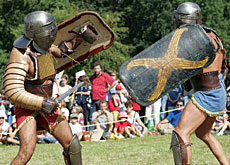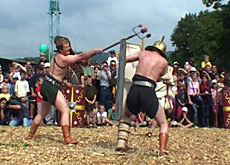Switzerland’s Roman heritage comes to life

The country's most important archaeological site is this year celebrating the 50th anniversary of its museum and Roman house.
Augusta Raurica, the first Roman colony to be built on the Rhine, receives 140,000 visitors every year and offers fascinating insights into the way the Romans lived.
In addition to a treasure chamber filled with precious silver, the museum contains a selection of the most important finds from the archaeological site, including a life-size bronze bust of the goddess Minerva.
The adjacent Roman house is a careful reconstruction of a Roman dwelling and workshop showing life as it would have been 2,000 years ago.
Founded in 44 BC in the vicinity of modern-day Basel by Lucius Munatius Plancus, a military commander and friend of Caesar, the original purpose of the Colonia Raurica was to defend Rome’s new frontier along the Rhine, following the conquest of Gaul.
The earliest evidence of Roman settlement at Augusta Raurica dates back to 15BC, when the Emperor Augustus incorporated the area which is now Switzerland into the Roman Empire.
From a military base, Augusta Raurica soon developed into a vital staging post and trading centre in a great single market which stretched from Britain in the north to Africa in the south, from the Iberian peninsula in the west to Asia in the east.
Just a few decades after its foundation, a building boom transformed the military encampment on the Rhine into one of the continent’s major cities. Wooden fortifications and houses were replaced by a grid layout of broad avenues fronted by imposing constructions in bricks and mortar.
Peaceful co-existence
“In the second century AD, Augusta Raurica had a population of at least 20,000, while today only 800 people live in the area,” explains Karin Kob, the archaeological site’s public relations manager.
“The Colonia Raurica is an excellent example of the ‘romanisation’ of the Empire: the natives co-existed peacefully with thousands of Roman legionaries, who after 20 years’ service were pensioned off and, as colonists, granted plots of land to farm.
A previously undreamed-of urban lifestyle, evidenced by luxurious villas, theatres, amphitheatres, public baths, markets and inns, opened minds and brought new pleasures to the Celtic peoples of these upland areas.
There was a dramatic leap forward in the standard of living: paved streets, drainage, clean running water for domestic use, under-floor heating. And even then the Mediterranean diet was gaining ground.
“The Romans had established an incredible trading and transport infrastructure. Amphorae of olive oil and wine brought from the islands of the Mediterranean have been found at Augusta Raurica. As have remains of fish, oysters, fruit and vegetables originating thousands of kilometres away,” explains Kob.
Craftsmen and gladiators
Buried for centuries following the invasion of “barbarian” Germanic peoples, Switzerland’s Roman heritage was not unearthed and given due prominence until fairly recent times.
Now at least 140,000 people visit Augusta Raurica each year. More than 15,000 visitors take part in the now traditional Roman festival, held in August, which enables them to rediscover the Roman way of life and customs.
“We have observed that the general public, accustomed to seeing only finished articles, are really fascinated by the opportunity to discover manufacturing techniques and know-how employed 2,000 years ago,” says archaeologist Max Zurbuchen.
Festival events including circus games, gladiatorial combat, chariot races, music and dance, also make visitors aware of just how much the Romans enjoyed spectacle and entertainment.
swissinfo, Armando Mombelli
140,000 people visit Augusta Raurica each year. Near Basel, it is Switzerland’s most important Roman archaeological site.
More than 15,000 visitors attended the tenth Roman Festival held on the site, on August 27 and 28 this year.
This year, Augusta Raurica is also celebrating the 50th anniversary of its museum and Roman house.
Following the occupation of Gaul by Caesar’s legions, in 44BC the Romans founded the Colonia Raurica in the vicinity of present-day Basel, the first Roman colony on the Rhine.
The earliest evidence of Roman occupation dates from 15AD.
During the second century AD, the original military encampment became the main Roman settlement in the area which is now Switzerland, with a population of over 20,000.
The decline and fall of Augusta Raurica is thought to have been caused by an earthquake (around 250AD), then by barbarian invasions in the 4th and 5th centuries AD.

In compliance with the JTI standards
More: SWI swissinfo.ch certified by the Journalism Trust Initiative











You can find an overview of ongoing debates with our journalists here . Please join us!
If you want to start a conversation about a topic raised in this article or want to report factual errors, email us at english@swissinfo.ch.